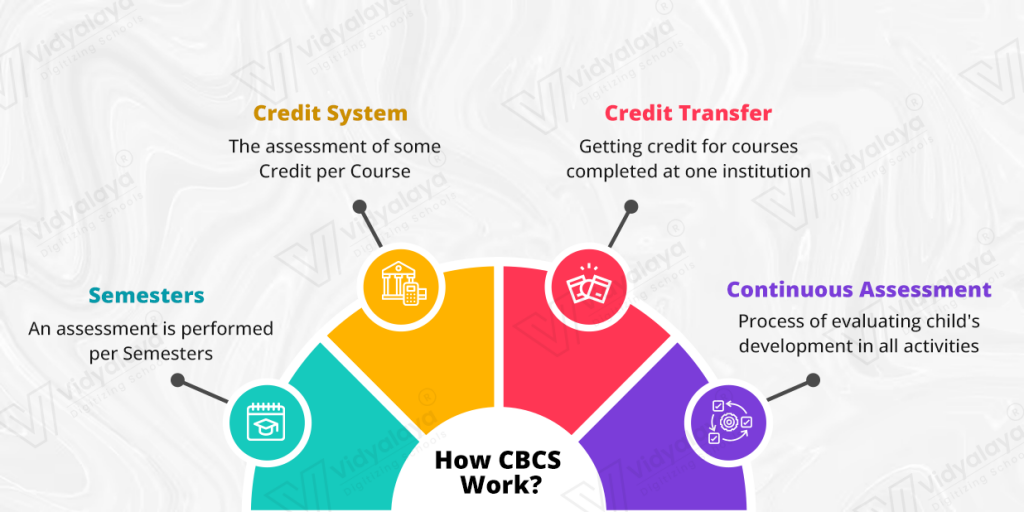At the start of every academic year, there are lots of discussions about the credit system, both current and advanced. Credit systems are important as they help you to understand your progress during your studies, especially in Bachelor’s, master’s, or Ph.D. Programme. Credit-based systems are considered as a measure to assess the students’ efforts and work during their higher education. Although different countries use different credit systems, choice based credit system is one of the most popular systems across the world. Looking at the growing significance of the method, ed-tech software like Vidyalaya brings automation and cuts down the redundancy in monotonous work.
In order to bring efficiency and excellence to higher education in India, UGC always seeks innovative and advanced methods of evaluation. To date, different universities follow different methods of evaluation and grading systems. There is a need for a comprehensive and universal grading system that is accessible to all. Vidyalaya identifies this need and expands the academic quality in all aspects through its tailor-made CBCS Software.
What is a Choice-Based Credit System?
We all grow up in a rigidly designed curriculum, where students need to learn the designed subjects without having a choice. Also, even after a hard patch of time, we needed to stretch ourselves to carry those overhyped premium percentage figures. Students from Arts were not allowed to select subjects from science discipline. University Grant Commission or UGC recognized such issues which were the blocks of the advanced learning process. To address these problems, UGC came up with a solution called Choice based credit system.
This comprehensive system is an evaluation program in which students can have a choice of selecting courses from the prescribed ones from core, elective or minor, or soft skill courses, which they can learn at their own pace, and evaluation is performed on a credit system. This system highly copes with the global education system and makes students familiar with it along with redefining the curriculum. Through this method, students get the easiest way to mobility to educational institutes as each of them follows the same evaluation credit system.
Vidyalaya, with more than 20+ years of experience in the Indian Education System, develops a choice-based credit system software to automate this process and bring efficient results to your table.
Here are the features of our CBCS software:
- We integrate uniformity for all levels of educational institutes ranging from central to state and private universities.
- Students can select from three main courses:
- Core
- Elective
- Foundation
- All these courses are evaluated and presented to students for effective and balanced results.
- Along with these credit-based courses, some non-credit courses are available which are evaluated as satisfactory or unsatisfactory. These courses are not considered in the CGPA/SGPA calculation.
Explain the working of CBCS:
CBCS software works on the simple principle of the choice offering in the students’ hands. Educational institutes offer a range of optional subjects from which students can select subjects according to their interests and credits necessary for the semester. After understanding what is CBCS, let us explain our CBCS Software which is based on four basic elements:
1. Semesters:
In this method, an assessment is performed per semester. The semester method evaluates students’ progress is evaluated on the basis of courses instead of specific time duration. Generally, each semester is comprised of 15-18 weeks of the academic schedule. This method is most popular because of the flexibility in designing the curriculum, credit assignments, and hours of teaching. Some institutes consider grades only for the semester and some institutes consider grades for all semesters during the entire course.
2. Credit System:
The Credit system enables the assignment of some credits per course. Students can earn credits after passing the course. Even if the student passes a single course in a particular semester, he/she doesn’t need to repeat that course later. The biggest advantage of this method is students can earn credit points according to his/her pace without taking any burden.
3. Credit Transfer:
Students may come across several severe issues like illness, and personal emergencies where they cannot concentrate on their studies and complete the semester. In that case, the credit transfer system comes in handy. In this method, the student gets the freedom to study fewer courses and earn less credits. He/she will also be able to compensate for this gap next semester.
4. Comprehensive Continuous Assessment:
Instead of periodic evaluation, some institutes believe in a continuous assessment method on which comprehensive continuous assessment method is based. During this method, teachers as well as the student him/herself continuously evaluate the progress. This evaluation can be done in any form like a 10-point grading system where 0 is rated as absent and 10 is for outstanding performance.
Here are the details of the grading system and their remarks:
- (Outstanding)= 10
- A+ (Excellent)=9
- A (Very Good) = 8
- B+ (Good)= 7
- B (Above Average) = 6
- C (Average) = 5
- P (Pass) = 4
- F (Fail) = 0
- Ab (Absent) = 0
What are the advantages and disadvantages of Choice based Credit system?
As every coin has two sides, a choice-based credit system comes with advantages and disadvantages sides. This method surpasses the conventional percentage and grading method and follows a standard way of evaluation and exam management. Let’s understand the pros and cons of this method in detail:
Advantages:
- Students get the freedom of choice of course selection where their interest matters. They are allowed to select the subjects of their own preferences.
- Students can learn at their own pace without bearing the pressure of studies. The purpose of enjoying education is satisfied here the most.
- Students can earn more credit points than required by studying additional courses. They get the benefits of acquiring additional knowledge and skills within less time.
- An interdisciplinary approach is also possible with this method where students can learn subjects of other disciplines also.
- This system is bliss for students who need frequent migrating. They can learn one part of the course at one institute and other at another institute. But it is mandatory that both institutes should follow this method.
- Instead of focusing on memorization and an exam-oriented approach, students can improve their skills through assignments, projects, vocational training, and entrepreneurship also.
- Choice based credit system improves the potential of students making them strong from the job perspective as they are evaluated on a more scientific scale in this method.
Disadvantages:
- Choice-based credit system evaluates students based on the points and not on the exact marks there is no exact figure but the estimation.
- Although there is flexibility in this method, teachers’ workloads may also fluctuate.
- To implement this method efficiently, educational institutes need to have good infrastructural support to spread education.
The choice based credit system is a completely student-centric educational model that offers freedom to students to choose courses and subjects of their own choice. With this approach, students get enormous benefits like learning at their own pace, achieving life goals with a completely new perspective, and others. Vidyalaya, a leading software provider, develops a dedicated choice-based credit system software that fulfills the guidelines of the CBCS pattern. Prefer us over the conservative approach and offer real freedom where students are enjoying their desired courses at their own pace and promote broad-based education!
































